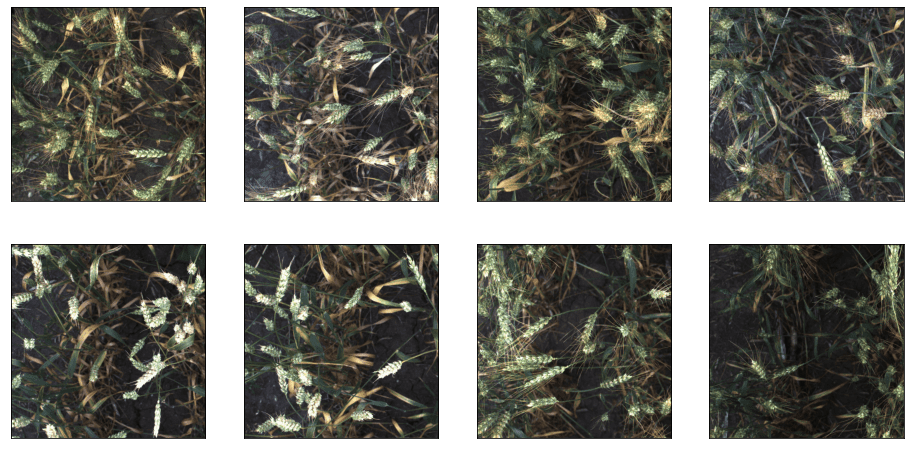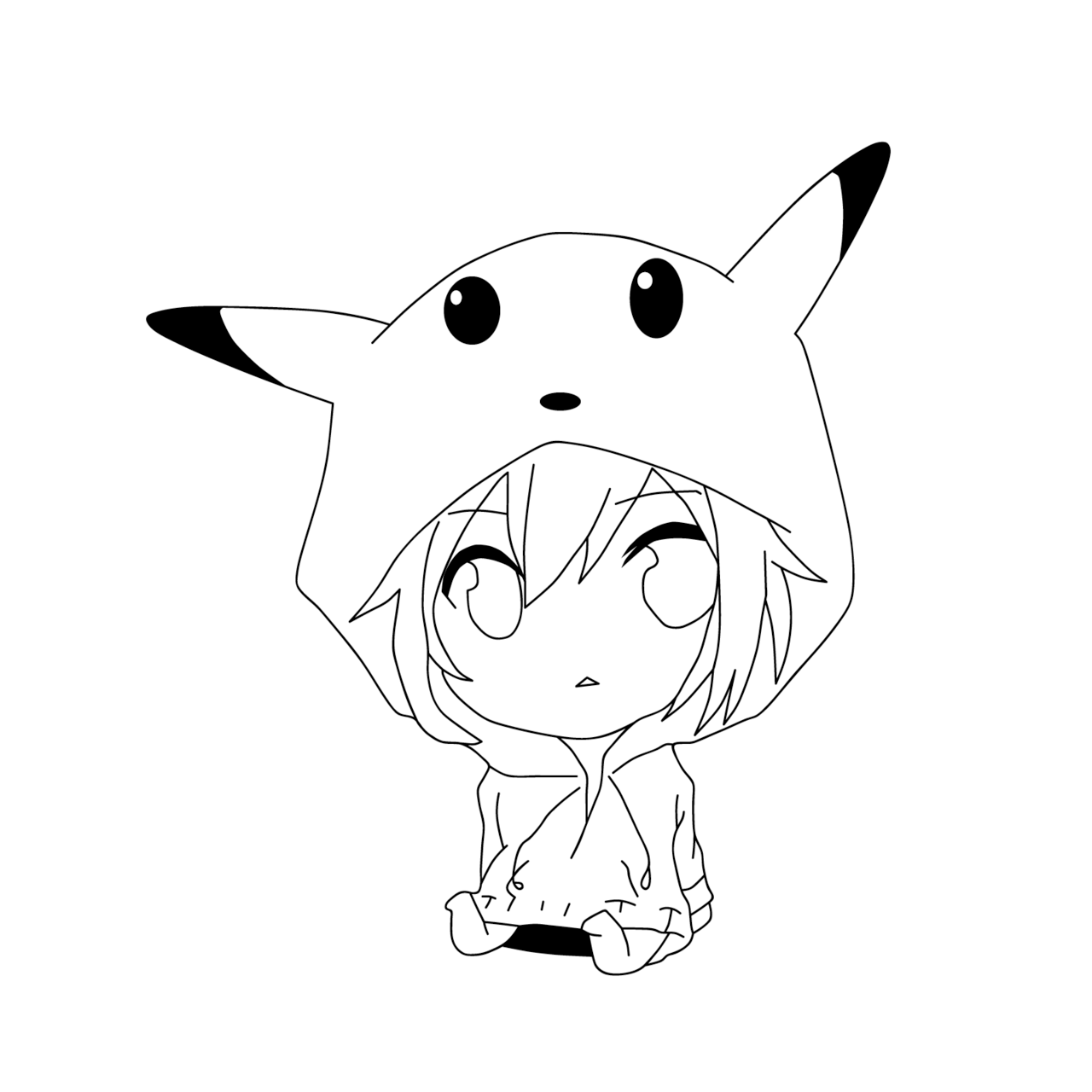本文将利用 TorchVision Faster R-CNN 预训练模型,于 Kaggle: 全球小麦检测 🌾 上实践迁移学习中的一种常用技术:微调(fine tuning)。
本文相关的 Kaggle Notebooks 可见:
如果你没有 GPU ,也可于 Kaggle 上在线训练。使用介绍:
那么,我们开始吧 💪
准备数据
import os
import numpy as np
import pandas as pd
import seaborn as sns
from matplotlib import pyplot as plt
from PIL import Image下载数据
Kaggle: 全球小麦检测 Data 页下载数据,内容如下:
- train.csv - the training data
- sample_submission.csv - a sample submission file in the correct format
- train.zip - training images
- test.zip - test images
DIR_INPUT = 'global-wheat-detection'
DIR_TRAIN = f'{DIR_INPUT}/train'
DIR_TEST = f'{DIR_INPUT}/test'读取数据
读取 train.csv 内容:
train_df = pd.read_csv(f'{DIR_INPUT}/train.csv')
train_df.head()
- image_id - the unique image ID
- width, height - the width and height of the images
- bbox - a bounding box, formatted as a Python-style list of [xmin, ymin, width, height]
- etc.
把 bbox 替换成 x y w h:
train_df[['x','y','w','h']] = 0
train_df[['x','y','w','h']] = np.stack(train_df['bbox'].apply(lambda x: np.fromstring(x[1:-1], sep=','))).astype(np.float)
train_df.drop(columns=['bbox'], inplace=True)
train_df.head()
分析数据
训练数据大小:
train_df.shape(147793, 8)
唯一 image_id 数量:
train_df['image_id'].nunique()3373
train 目录下图片数量:
len(os.listdir(DIR_TRAIN))3423
说明有 3422-3373=49 张图片没有标注。
训练数据,图片大小:
train_df['width'].unique(), train_df['height'].unique()(array([1024]), array([1024]))
都是 1024x1024 的。
查看标注数量的分布情况:
counts = train_df['image_id'].value_counts()
print(f'number of boxes, range [{min(counts)}, {max(counts)}]')
sns.displot(counts, kde=False)
plt.xlabel('boxes')
plt.ylabel('images')
plt.title('boxes vs. images')
plt.show()number of boxes, range [1, 116]

一张图最多的有 116 个标注。
查看标注坐标和宽高的分布情况:
train_df['cx'] = train_df['x'] + train_df['w'] / 2
train_df['cy'] = train_df['y'] + train_df['h'] / 2
ax = plt.subplots(1, 4, figsize=(16, 4), tight_layout=True)[1].ravel()
ax[0].set_title('x vs. y')
ax[0].set_xlim(0, 1024)
ax[0].set_ylim(0, 1024)
ax[1].set_title('cx vs. cy')
ax[1].set_xlim(0, 1024)
ax[1].set_ylim(0, 1024)
ax[2].set_title('w vs. h')
ax[3].set_title('area size')
sns.histplot(data=train_df, x='x', y='y', ax=ax[0], bins=50, pmax=0.9)
sns.histplot(data=train_df, x='cx', y='cy', ax=ax[1], bins=50, pmax=0.9)
sns.histplot(data=train_df, x='w', y='h', ax=ax[2], bins=50, pmax=0.9)
sns.histplot(train_df['w'] * train_df['h'], ax=ax[3], bins=50, kde=False)
plt.show()
把数据集分为训练集和验证集,比例 8:2:
image_ids = train_df['image_id'].unique()
split_len = round(len(image_ids)*0.8)
train_ids = image_ids[:split_len]
valid_ids = image_ids[split_len:]
train = train_df[train_df['image_id'].isin(train_ids)]
valid = train_df[train_df['image_id'].isin(valid_ids)]
train.shape, valid.shape((122577, 10), (25216, 10))
预览数据
定义下辅助函数:
def show_images(imgs, num_rows, num_cols, titles=None, scale=1.5):
figsize = (num_cols * scale, num_rows * scale)
_, axes = plt.subplots(num_rows, num_cols, figsize=figsize)
axes = axes.flatten()
for i, (ax, img) in enumerate(zip(axes, imgs)):
ax.imshow(img)
ax.axes.get_xaxis().set_visible(False)
ax.axes.get_yaxis().set_visible(False)
if titles and len(titles) > i:
ax.set_title(titles[i])
return axes
def show_bboxes(axes, bboxes, labels=None, colors=None):
def _make_list(obj, default_values=None):
if obj is None:
obj = default_values
elif not isinstance(obj, (list, tuple)):
obj = [obj]
return obj
labels = _make_list(labels)
colors = _make_list(colors, ['b', 'g', 'r', 'm', 'c'])
for i, bbox in enumerate(bboxes):
color = colors[i % len(colors)]
rect = plt.Rectangle(
xy=(bbox[0], bbox[1]),
width=bbox[2] - bbox[0],
height=bbox[3] - bbox[1],
fill=False,
edgecolor=color,
linewidth=2)
axes.add_patch(rect)
if labels and len(labels) > i:
text_color = 'k' if color == 'w' else 'w'
axes.text(rect.xy[0], rect.xy[1], labels[i], va='center',
ha='center', fontsize=9, color=text_color,
bbox=dict(facecolor=color, lw=0))
# https://github.com/d2l-ai/d2l-en/blob/master/d2l/torch.py预览图片,不加标注:
num_rows, num_cols = 2, 4
imgs = [plt.imread(f'{DIR_TRAIN}/{n}.jpg') for n in train_df['image_id'].unique()[:num_rows*num_cols]]
show_images(imgs, num_rows, num_cols, scale=4)
plt.show()
预览图片,加上标注:
num_rows, num_cols = 1, 2
ids = train_df['image_id'].unique()[:num_rows*num_cols]
imgs = [plt.imread(f'{DIR_TRAIN}/{n}.jpg') for n in ids]
axes = show_images(imgs, num_rows, num_cols, scale=8)
for ax, id in zip(axes, ids):
datas = train_df[train_df['image_id'] == id]
bboxes = [(d['x'], d['y'], d['x']+d['w'], d['y']+d['h']) for _, d in datas.iterrows()]
show_bboxes(ax, bboxes, labels=None, colors=['w'])
plt.show()
创建 Dataset
继承 torch.utils.data.Dataset 抽象类,实现 __len__ __getitem__ 。且 __getitem__ 返回数据为:
- image: a
numpy.ndarrayimage - target: a dict containing the following fields
boxes(FloatTensor[N, 4]): the coordinates of theNbounding boxes in[x0, y0, x1, y1]format, ranging from0toWand0toHlabels(Int64Tensor[N]): the label for each bounding boximage_id(Int64Tensor[1]): an image identifier. It should be unique between all the images in the dataset, and is used during evaluationarea(Tensor[N]): The area of the bounding box. This is used during evaluation with the COCO metric, to separate the metric scores between small, medium and large boxes.iscrowd(UInt8Tensor[N]): instances withiscrowd=Truewill be ignored during evaluation.
import cv2 as cv
import numpy as np
import albumentations as A
from albumentations.pytorch.transforms import ToTensorV2
import torch
from torch.utils.data import Dataset
class Wheat(Dataset):
def __init__(self, dataframe, image_dir, transforms=None):
super().__init__()
self.image_ids = dataframe['image_id'].unique()
self.df = dataframe
self.image_dir = image_dir
self.transforms = transforms
def __getitem__(self, idx: int):
image_id = self.image_ids[idx]
records = self.df[self.df['image_id'] == image_id]
image = cv.imread(f'{self.image_dir}/{image_id}.jpg', cv.IMREAD_COLOR)
image = cv.cvtColor(image, cv.COLOR_BGR2RGB).astype(np.float32)
image /= 255.0
boxes = records[['x', 'y', 'w', 'h']].values
area = boxes[:, 2] * boxes[:, 3]
area = torch.as_tensor(area, dtype=torch.float32)
boxes[:, 2] = boxes[:, 0] + boxes[:, 2]
boxes[:, 3] = boxes[:, 1] + boxes[:, 3]
# there is only one class
labels = torch.ones((records.shape[0],), dtype=torch.int64)
# suppose all instances are not crowd
iscrowd = torch.zeros((records.shape[0],), dtype=torch.uint8)
target = {}
target['boxes'] = boxes
target['labels'] = labels
target['image_id'] = torch.tensor([idx])
target['area'] = area
target['iscrowd'] = iscrowd
if self.transforms:
sample = {
'image': image,
'bboxes': target['boxes'],
'labels': labels,
}
sample = self.transforms(**sample)
image = sample['image']
target['boxes'] = torch.stack(tuple(map(torch.tensor, zip(*sample['bboxes'])))).permute(1, 0)
return image, target, image_id
def __len__(self) -> int:
return len(self.image_ids)
# albumentations
# https://github.com/albumentations-team/albumentations
@staticmethod
def get_train_transform():
return A.Compose([
A.Flip(0.5),
ToTensorV2(p=1.0)
], bbox_params={'format': 'pascal_voc', 'label_fields': ['labels']})
@staticmethod
def get_valid_transform():
return A.Compose([
ToTensorV2(p=1.0)
], bbox_params={'format': 'pascal_voc', 'label_fields': ['labels']})albumentations 是一个优秀的图像增强的库,用它定义了 train valid 的转换方法。
现在创建 train valid 数据集:
train_dataset = Wheat(train, DIR_TRAIN, Wheat.get_train_transform())
valid_dataset = Wheat(valid, DIR_TRAIN, Wheat.get_valid_transform())预览下数据集里的图片:
datas = [train_dataset[i] for i in range(2)]
imgs = [d[0].permute(1, 2, 0).numpy() for d in datas]
axes = show_images(imgs, 1, 2, scale=8)
for ax, (image, target, image_id) in zip(axes, datas):
show_bboxes(ax, target['boxes'], labels=None, colors=['w'])
plt.show()
准备模型
import torchvision
from torchvision.models.detection.faster_rcnn import FastRCNNPredictor
from torchvision.models.detection import FasterRCNN
from torchvision.models.detection.rpn import AnchorGenerator创建模型
创建一个 Faster R-CNN 预训练模型:
model = torchvision.models.detection.fasterrcnn_resnet50_fpn(pretrained=True)微调模型
输出模型最后一层:
print(model.roi_heads.box_predictor)FastRCNNPredictor( (cls_score): Linear(in_features=1024, out_features=91, bias=True) (bbox_pred): Linear(in_features=1024, out_features=364, bias=True) )
替换该层,指明输出特征大小为 2:
num_classes = 2 # wheat or not(background)
# get number of input features for the classifier
in_features = model.roi_heads.box_predictor.cls_score.in_features
# replace the pre-trained model's head with a new one
model.roi_heads.box_predictor = FastRCNNPredictor(in_features, num_classes)再次输出模型最后一层:
print(model.roi_heads.box_predictor)FastRCNNPredictor( (cls_score): Linear(in_features=1024, out_features=2, bias=True) (bbox_pred): Linear(in_features=1024, out_features=8, bias=True) )
训练模型
创建 DataLoader
from torch.utils.data import DataLoader
def collate_fn(batch):
return tuple(zip(*batch))
train_data_loader = DataLoader(
train_dataset,
batch_size=4,
shuffle=False,
num_workers=4,
collate_fn=collate_fn
)
valid_data_loader = DataLoader(
valid_dataset,
batch_size=4,
shuffle=False,
num_workers=4,
collate_fn=collate_fn
)创建参数
# train on the GPU or on the CPU, if a GPU is not available
device = torch.device('cuda') if torch.cuda.is_available() else torch.device('cpu')
# move model to the right device
model.to(device)
# create an optimizer
params = [p for p in model.parameters() if p.requires_grad]
optimizer = torch.optim.SGD(params, lr=0.005, momentum=0.9, weight_decay=0.0005)
# create a learning rate scheduler
# lr_scheduler = torch.optim.lr_scheduler.StepLR(optimizer, step_size=3, gamma=0.1)
lr_scheduler = None
# train it for 10 epochs
num_epochs = 10开始训练
import time
from tqdm import tqdm
#from tqdm.notebook import tqdm as tqdm
itr = 1
total_train_loss = []
total_valid_loss = []
losses_value = 0
for epoch in range(num_epochs):
start_time = time.time()
# train ------------------------------
model.train()
train_loss = []
pbar = tqdm(train_data_loader, desc='let\'s train')
for images, targets, image_ids in pbar:
images = list(image.to(device) for image in images)
targets = [{k: v.to(device) for k, v in t.items()} for t in targets]
loss_dict = model(images, targets)
losses = sum(loss for loss in loss_dict.values())
losses_value = losses.item()
train_loss.append(losses_value)
optimizer.zero_grad()
losses.backward()
optimizer.step()
pbar.set_description(f"Epoch: {epoch+1}, Batch: {itr}, Loss: {losses_value}")
itr += 1
epoch_train_loss = np.mean(train_loss)
total_train_loss.append(epoch_train_loss)
# update the learning rate
if lr_scheduler is not None:
lr_scheduler.step()
# valid ------------------------------
with torch.no_grad():
valid_loss = []
for images, targets, image_ids in valid_data_loader:
images = list(image.to(device) for image in images)
targets = [{k: v.to(device) for k, v in t.items()} for t in targets]
loss_dict = model(images, targets)
losses = sum(loss for loss in loss_dict.values())
loss_value = losses.item()
valid_loss.append(loss_value)
epoch_valid_loss = np.mean(valid_loss)
total_valid_loss.append(epoch_valid_loss)
# print ------------------------------
print(f"Epoch Completed: {epoch+1}/{num_epochs}, Time: {time.time()-start_time}, "
f"Train Loss: {epoch_train_loss}, Valid Loss: {epoch_valid_loss}")Epoch: 1, Batch: 675, Loss: 0.8600306952323752: 100%|██████████| 675/675 [08:26<00:00, 1.33it/s] Epoch Completed: 1/2, Time: 566.7130048274994, Train Loss: 0.909390335455138, Valid Loss: 0.8790632066434829 Epoch: 2, Batch: 1350, Loss: 0.8195391336080114: 100%|██████████| 675/675 [08:27<00:00, 1.33it/s] Epoch Completed: 2/2, Time: 569.5055477619171, Train Loss: 0.8158109236268262, Valid Loss: 0.8743081629490502 ...
绘制 Loss
plt.figure(figsize=(8, 5))
sns.set_style(style="whitegrid")
sns.lineplot(x=range(1, len(total_train_loss)+1), y=total_train_loss, label="Train Loss")
sns.lineplot(x=range(1, len(total_train_loss)+1), y=total_valid_loss, label="Valid Loss")
plt.xlabel("Epochs")
plt.ylabel("Loss")
plt.show()
保存模型
torch.save(model.state_dict(), 'fasterrcnn_resnet50_fpn.pth')模型预测
这里我们从头准备数据,再载入模型,进行预测。
准备数据
import os
import numpy as np
import pandas as pd
import seaborn as sns
from matplotlib import pyplot as plt
from PIL import Image
DIR_INPUT = 'global-wheat-detection'
DIR_TRAIN = f'{DIR_INPUT}/train'
DIR_TEST = f'{DIR_INPUT}/test'
WEIGHTS_FILE = 'fasterrcnn_resnet50_fpn.pth'Submission 文件
用于提交结果的文件。一行内容,表示一个图片的预测结果。如下:
ce4833752,0.5 0 0 100 100
image_id ce4833752 的图片,预测出 x y w h 0 0 100 100 处是小麦,置信度 0.5。如果有多个预测框,能空格分隔。
test_df = pd.read_csv(f'{DIR_INPUT}/sample_submission.csv')
test_df.tail()
创建 Dataset
import cv2 as cv
import numpy as np
import albumentations as A
from albumentations.pytorch.transforms import ToTensorV2
import torch
from torch.utils.data import Dataset
class WheatTest(Dataset):
def __init__(self, image_ids, image_dir, transforms=None):
super().__init__()
self.image_ids = image_ids
self.image_dir = image_dir
self.transforms = transforms
def __getitem__(self, idx: int):
image_id = self.image_ids[idx]
image = cv.imread(f'{self.image_dir}/{image_id}.jpg', cv.IMREAD_COLOR)
image = cv.cvtColor(image, cv.COLOR_BGR2RGB).astype(np.float32)
image /= 255.0
if self.transforms:
sample = {
'image': image,
}
sample = self.transforms(**sample)
image = sample['image']
return image, image_id
def __len__(self) -> int:
return len(self.image_ids)
@staticmethod
def get_test_transform():
return A.Compose([
ToTensorV2(p=1.0)
])实例化测试数据集:
def get_image_ids(p):
import glob
image_ids = []
for p in glob.glob(f'{p}/*.jpg'):
n, _ = os.path.splitext(os.path.basename(p))
image_ids.append(n)
return image_ids
# try more images for submission
#test_dataset = WheatTest(get_image_ids(DIR_TRAIN), DIR_TRAIN, WheatTest.get_test_transform())
test_dataset = WheatTest(test_df["image_id"].unique(), DIR_TEST, WheatTest.get_test_transform())创建 DataLoader
from torch.utils.data import DataLoader
def collate_fn(batch):
return tuple(zip(*batch))
test_data_loader = DataLoader(
test_dataset,
batch_size=2,
shuffle=False,
num_workers=4,
drop_last=False,
collate_fn=collate_fn
)载入模型
import torchvision
from torchvision.models.detection.faster_rcnn import FastRCNNPredictor
from torchvision.models.detection import FasterRCNN
from torchvision.models.detection.rpn import AnchorGenerator
device = torch.device('cuda') if torch.cuda.is_available() else torch.device('cpu')
# create a Faster R-CNN model without pre-trained
model = torchvision.models.detection.fasterrcnn_resnet50_fpn(pretrained=False, pretrained_backbone=False)
num_classes = 2 # wheat or not(background)
# get number of input features for the classifier
in_features = model.roi_heads.box_predictor.cls_score.in_features
# replace the pre-trained model's head with a new one
model.roi_heads.box_predictor = FastRCNNPredictor(in_features, num_classes)
# load the trained weights
model.load_state_dict(torch.load(WEIGHTS_FILE, map_location=device))
model.eval()
# move model to the right device
_ = model.to(device)开始预测
score_threshold = 0.7
image_outputs = []
for images, image_ids in test_data_loader:
images = list(image.to(device) for image in images)
outputs = model(images)
for image_id, output in zip(image_ids, outputs):
boxes = output['boxes'].data.cpu().numpy()
scores = output['scores'].data.cpu().numpy()
mask = scores >= score_threshold
boxes = boxes[mask].astype(np.int32)
scores = scores[mask]
image_outputs.append((image_id, boxes, scores))预览结果
num_rows, num_cols = 1, 2
scale = 16
figsize = (num_rows * scale, num_cols * scale)
_, axes = plt.subplots(num_rows, num_cols, figsize=figsize)
axes = axes.flatten()
fig_n = num_rows * num_cols
fig_i = 0
for i in range(1, 1+fig_n):
image, image_id = test_dataset[i]
_, boxes, scores = image_outputs[i]
sample = image.permute(1, 2, 0).cpu().numpy()
for box in boxes:
cv.rectangle(sample, (box[0], box[1]), (box[2], box[3]), (220, 0, 0), 2)
axes[fig_i].imshow(sample)
fig_i += 1
保存结果
def format_prediction_string(boxes, scores):
pred_strings = []
for score, box in zip(scores, boxes):
pred_strings.append(round(score, 4))
pred_strings.extend(box)
return ' '.join(map(str, pred_strings))
results = []
for image_id, boxes, scores in image_outputs:
#boxes = boxes_.copy()
boxes[:, 2] = boxes[:, 2] - boxes[:, 0]
boxes[:, 3] = boxes[:, 3] - boxes[:, 1]
result = {
'image_id': image_id,
'PredictionString': format_prediction_string(boxes, scores)
}
results.append(result)
results[0]{'image_id': 'aac893a91', 'PredictionString': '0.9928 72 2 96 166 0.9925 553 528 123 203 0.9912 613 921 85 102 0.9862 691 392 125 193 0.9855 819 708 105 204 0.9842 356 531 100 88 0.982 586 781 100 119 0.9795 739 768 82 122 0.9779 324 662 126 160 0.9764 27 454 102 156 0.9763 545 76 145 182 0.9736 450 858 90 95 0.9626 241 91 137 146 0.9406 306 0 75 68 0.9404 89 618 128 80 0.9366 177 576 114 182 0.9363 234 845 144 91 0.9265 64 857 115 69 0.824 822 630 90 124 0.7516 815 921 134 100'}
test_df = pd.DataFrame(results, columns=['image_id', 'PredictionString'])
test_df
test_df.to_csv('submission.csv', index=False)提交结果

这就是 baseline 了,可以试着继续调优 😊
参考
GoCoding 个人实践的经验分享,可关注公众号!











